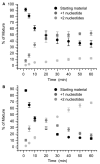Excision of a lyase-resistant oxidized abasic lesion from DNA
- PMID: 20232790
- PMCID: PMC2863051
- DOI: 10.1021/tx9003984
Excision of a lyase-resistant oxidized abasic lesion from DNA
Abstract
The C2'-oxidized abasic lesion (C2-AP) is produced in DNA that is subjected to oxidative stress. The lesion disrupts replication and gives rise to mutations that are dependent upon the identity of the upstream nucleotide. Ape1 incises C2-AP, but the 5'-phosphorylated fragment is not a substrate for the lyase activity of DNA polymerase beta. Excision of the lesion is achieved by strand displacement synthesis in the presence of flap endonuclease during which C2-AP and the 3'-adjacent nucleotide are replaced. The oxidized abasic lesion is also a substrate for the bacterial UvrABC nucleotide excision repair system. These data suggest that the redundant nature of DNA repair systems provides a means for removing a lesion that resists excision by short patch base excision repair.
Figures






Similar articles
-
Long patch base excision repair compensates for DNA polymerase β inactivation by the C4'-oxidized abasic site.Biochemistry. 2011 Jan 11;50(1):136-43. doi: 10.1021/bi1017667. Epub 2010 Dec 14. Biochemistry. 2011. PMID: 21155533 Free PMC article.
-
In vitro replication and repair of DNA containing a C2'-oxidized abasic site.Biochemistry. 2004 Dec 7;43(48):15217-22. doi: 10.1021/bi048360c. Biochemistry. 2004. PMID: 15568814
-
Excision of C-4'-oxidized deoxyribose lesions from double-stranded DNA by human apurinic/apyrimidinic endonuclease (Ape1 protein) and DNA polymerase beta.J Biol Chem. 1998 Oct 30;273(44):28837-44. doi: 10.1074/jbc.273.44.28837. J Biol Chem. 1998. PMID: 9786884
-
When DNA repair goes wrong: BER-generated DNA-protein crosslinks to oxidative lesions.DNA Repair (Amst). 2016 Aug;44:103-109. doi: 10.1016/j.dnarep.2016.05.014. Epub 2016 May 20. DNA Repair (Amst). 2016. PMID: 27264558 Free PMC article. Review.
-
Roles of base excision repair subpathways in correcting oxidized abasic sites in DNA.FEBS J. 2006 Apr;273(8):1620-9. doi: 10.1111/j.1742-4658.2006.05192.x. FEBS J. 2006. PMID: 16623699 Review.
Cited by
-
Repair of the major lesion resulting from C5'-oxidation of DNA.Biochemistry. 2011 Jul 19;50(28):6273-9. doi: 10.1021/bi200787e. Epub 2011 Jun 22. Biochemistry. 2011. PMID: 21696131 Free PMC article.
-
Base excision repair and lesion-dependent subpathways for repair of oxidative DNA damage.Antioxid Redox Signal. 2011 Jun 15;14(12):2491-507. doi: 10.1089/ars.2010.3466. Epub 2010 Oct 28. Antioxid Redox Signal. 2011. PMID: 20649466 Free PMC article. Review.
-
Inhibition of short patch and long patch base excision repair by an oxidized abasic site.Biochemistry. 2010 Nov 16;49(45):9904-10. doi: 10.1021/bi101533a. Epub 2010 Oct 20. Biochemistry. 2010. PMID: 20961055 Free PMC article.
-
Recognition and repair of chemically heterogeneous structures at DNA ends.Environ Mol Mutagen. 2015 Jan;56(1):1-21. doi: 10.1002/em.21892. Epub 2014 Aug 11. Environ Mol Mutagen. 2015. PMID: 25111769 Free PMC article. Review.
-
Abasic and oxidized abasic site reactivity in DNA: enzyme inhibition, cross-linking, and nucleosome catalyzed reactions.Acc Chem Res. 2014 Feb 18;47(2):646-55. doi: 10.1021/ar400229d. Epub 2013 Dec 26. Acc Chem Res. 2014. PMID: 24369694 Free PMC article.
References
-
- Li MJ, Liu L, Wei K, Fu Y, Guo QX. Significant effects of phosphorylation on relative stabilities of DNA and RNA sugar radicals: remarkably high susceptibility of H-2′ abstraction in RNA. J Phys Chem B. 2006;110:13582–13589. - PubMed
-
- von Sonntag C. The Chemical Basis of Radiation Biology. Taylor & Francis; London: 1987.
-
- Sugiyama H, Fujimoto K, Saito I. Evidence for intrastrand C2′ hydrogen abstraction in photoirradiation of 5-halouracil-containing oligonucleotides by using stereospecifically C2′-deuterated deoxyadenosine. Tetrahedron Lett. 1996;37:1805–1808.
-
- Sugiyama H, Fujimoto K, Saito I. Stereospecific 1,2-hydride shift in ribonolactone formation in the photoreaction of 2′-iododeoxyuridine. J Am Chem Soc. 1995;117:2945–2946.
-
- Sugiyama H, Tsutsumi Y, Fujimoto K, Saito I. Photoinduced deoxyribose C2′ oxidation in DNA. Alkali-dependent cleavage of erythrose-containing sites via a retroaldol reaction. J Am Chem Soc. 1993;115:4443–4448.
Publication types
MeSH terms
Substances
Grants and funding
LinkOut - more resources
Full Text Sources
Research Materials
Miscellaneous

